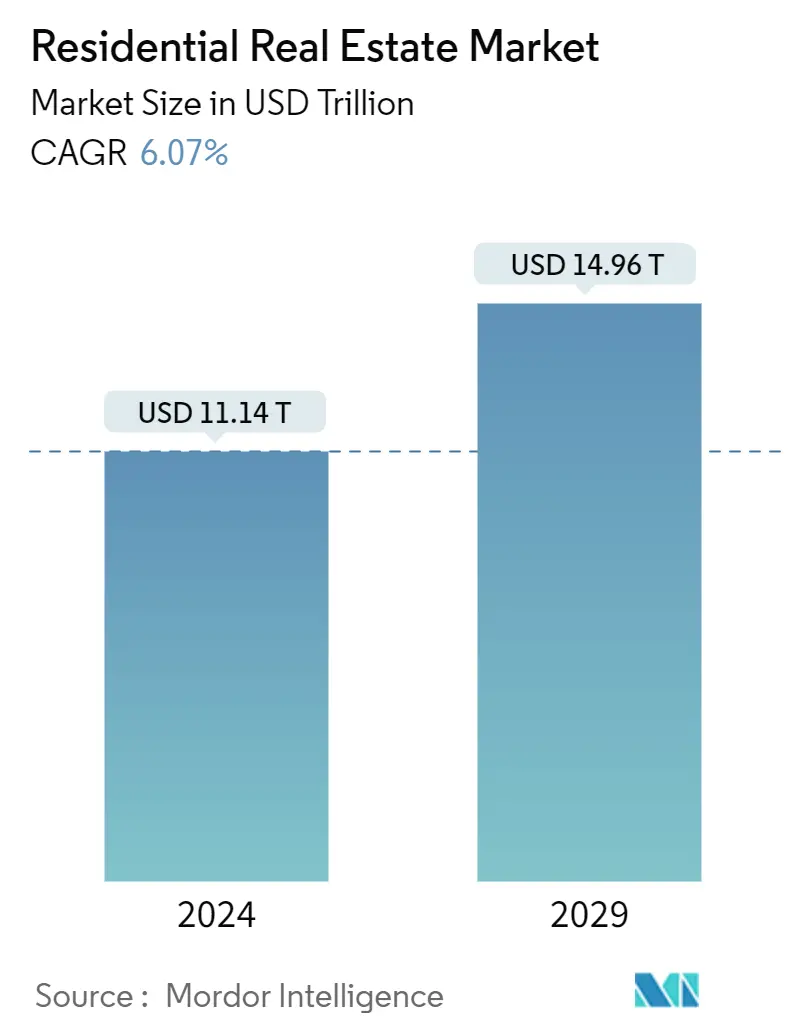Market Size of Residential Real Estate Industry

| Study Period | 2019-2029 |
| Market Size (2024) | USD 11.14 Trillion |
| Market Size (2029) | USD 14.96 Trillion |
| CAGR (2024 - 2029) | 6.07 % |
| Fastest Growing Market | Asia-Pacific |
| Largest Market | Asia-Pacific |
| Market Concentration | Low |
Major Players
*Disclaimer: Major Players sorted in no particular order |
Residential Real Estate Market Analysis
The Residential Real Estate Market size is estimated at USD 11.14 trillion in 2024, and is expected to reach USD 14.96 trillion by 2029, growing at a CAGR of 6.07% during the forecast period (2024-2029).
- The third quarter of 2022 saw an increase in economic headwinds; major economies are predicted to enter a recession in the upcoming period. However, certain nations, including those exporting commodities, are doing much better, indicating an uneven downturn. Further rate rises are projected through 2023 as central banks continue to take serious action to fight this. Occupiers are taking a more cautious approach now that decision-making processes are taking longer and, in some circumstances, standards are being lowered. These factors have decreased invest r confidence and transaction volumes in capital markets.
- The cost of newly listed homes in the United States has increased by 26.5% since March 2020 and 13.5% since the same period in 2021. Prices have cl bed by 9.1% in major urban regions like New York, Chicago, and Dallas/Fort Worth. The median active listing price in March 2022 was USD 405,000, an 8% rise from the median active listing price in the same month the previous year.
- The nationwide inventory of active listings fell by 18.9% due to the rising demand. This real estate statistic shows that more people are looking for homes than available homes for sale, a situation known as a seller's market, which raises prices and causes a shortage.
- Furthermore, government measures in promoting affordable housing stimulate market expansion. Governments in Australia, the United States, and Canada have planned strategies such as concessions for first-time buyers, veterans' subsidies, a golden visa, low-cost affordable housing schemes, and a reduction in transactional taxes, all of which are expected to boost growth in the residential real estate market. Even the low m mortgage interest rates fuel the residential real estate market in countries like the United States, Canada, India, and Australia.
Residential Real Estate Industry Segmentation
Residential real estate is an area developed for people to live. As defined by local zoning ordinances, residential real estate cannot be used for commercial or industrial purposes. A complete background analysis of the Residential Real Estate Market, including the assessment of the economy and contribution of sectors in the economy, market overview, market size estimation for key segments, and emerging trends in the market segments, market dynamics, and geographical trends, and COVID-19 impact is included in the report.
The Residential Real Estate Market is segmented by type (apartments and condominiums and landed houses and villas) and geography (North America, Europe, Asia-Pacific, Middle East & Africa, Latin America, and the Rest of the World). The report offers the market sizes and forecasts for the Residential Real Estate market in value (USD) for all the above segments.
| Type | |
| Apartments and Condominiums | |
| Landed Houses and Villas |
| Geography | ||||||||
| ||||||||
| ||||||||
| ||||||||
| ||||||||
| ||||||||
| Rest of the World |
Residential Real Estate Market Size Summary
The residential real estate market is poised for significant growth over the forecast period, driven by various economic and demographic factors. Despite economic challenges and potential recessions in major economies, certain countries, particularly those with strong commodity exports, are experiencing robust performance. This uneven economic landscape has led to cautious decision-making among occupiers and decreased investor confidence, impacting transaction volumes in capital markets. However, government initiatives promoting affordable housing and favorable mortgage rates in countries like the United States, Canada, India, and Australia are expected to stimulate market expansion. The ongoing urbanization trend, with a substantial portion of the global population moving to cities, further fuels the demand for residential properties, although it also presents challenges in meeting the need for affordable housing and infrastructure.
The market is characterized by its fragmented and competitive nature, with both regional and international players actively participating. Companies such as Savills PLC and Sun Hung Kai Properties operate on a global scale, while regional giants like DLF in India and KB Homes in the United States dominate their local markets. These major players are employing strategies like acquisitions, joint ventures, and strategic alliances to enhance their market presence and service offerings. The impact of lower mortgage rates is particularly notable, as they make homeownership more accessible, stimulate housing market activity, and encourage new residential projects. This dynamic environment, coupled with strategic expansions and developments by key players, underscores the evolving landscape of the residential real estate market.
Residential Real Estate Market Size - Table of Contents
-
1. MARKET INSIGHTS
-
1.1 Current Market Scenario
-
1.2 Residential Real Estate Buying Trends - Socioeconomic and Demographic Insights
-
1.3 Government Initiatives and Regulatory Aspects Pertaining to the Residential Real Estate Sector
-
1.4 Insights into the Size of Real Estate Lending and Loan-to-value Trends
-
1.5 Insights into the Interest Rates for the General Economy and Real Estate Lending
-
1.6 Insights into the Rental Yields in the Residential Real Estate Sector
-
1.7 Insights into the Capital Market Penetration and REIT Presence in the Residential Real Estate Sector
-
1.8 Insights into the Support Provided by the Government and Public-private Partnerships for Affordable Housing
-
1.9 Insights into the Tech and Startups Active in the Real Estate Sector (Broking, Social Media, Facility Management, and Property Management)
-
1.10 Impact of COVID-19 on the Market
-
-
2. MARKET SEGMENTATION
-
2.1 Type
-
2.1.1 Apartments and Condominiums
-
2.1.2 Landed Houses and Villas
-
-
2.2 Geography
-
2.2.1 North America
-
2.2.1.1 United States
-
2.2.1.2 Canada
-
-
2.2.2 Europe
-
2.2.2.1 United Kingdom
-
2.2.2.2 France
-
2.2.2.3 Germany
-
2.2.2.4 Rest of Europe
-
-
2.2.3 Asia-Pacific
-
2.2.3.1 China
-
2.2.3.2 India
-
2.2.3.3 Japan
-
2.2.3.4 South Korea
-
2.2.3.5 Australia
-
2.2.3.6 Rest of Asia-Pacific
-
-
2.2.4 Middle East & Africa
-
2.2.4.1 United Arab Emirates
-
2.2.4.2 Saudi Arabia
-
2.2.4.3 South Africa
-
2.2.4.4 Rest of Middle East & Africa
-
-
2.2.5 Latin America
-
2.2.5.1 Brazil
-
2.2.5.2 Argentina
-
2.2.5.3 Rest of Latin America
-
-
2.2.6 Rest of the World
-
-
Residential Real Estate Market Size FAQs
How big is the Residential Real Estate Market?
The Residential Real Estate Market size is expected to reach USD 11.14 trillion in 2024 and grow at a CAGR of 6.07% to reach USD 14.96 trillion by 2029.
What is the current Residential Real Estate Market size?
In 2024, the Residential Real Estate Market size is expected to reach USD 11.14 trillion.

